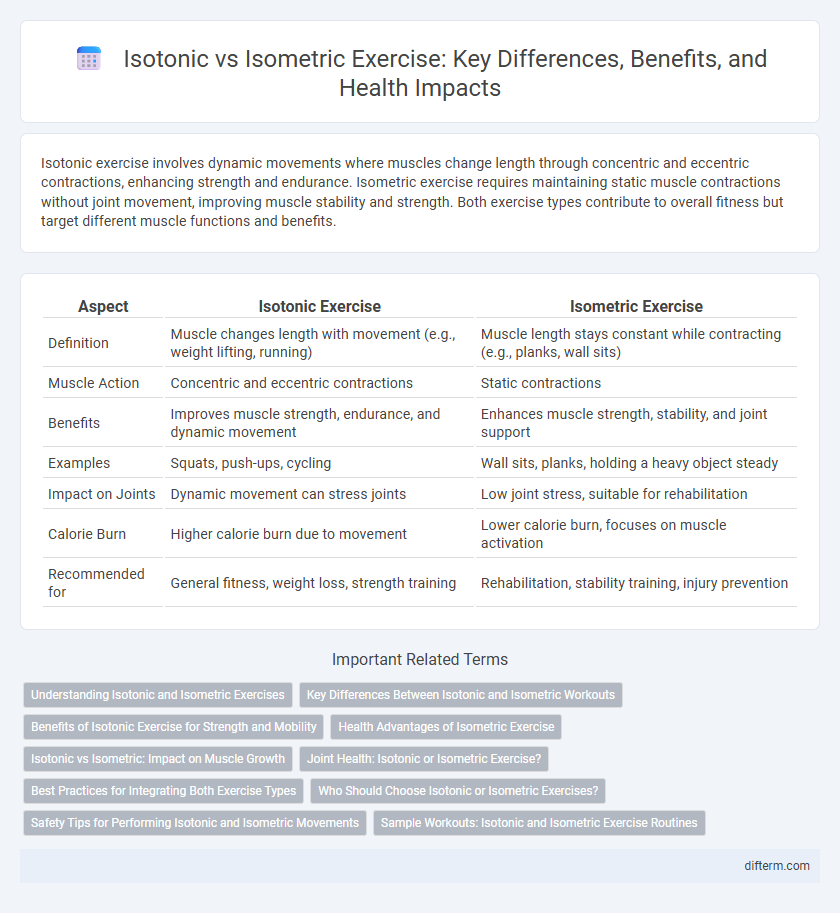Isotonic exercise involves dynamic movements where muscles change length through concentric and eccentric contractions, enhancing strength and endurance. Isometric exercise requires maintaining static muscle contractions without joint movement, improving muscle stability and strength. Both exercise types contribute to overall fitness but target different muscle functions and benefits.
Table of Comparison
| Aspect | Isotonic Exercise | Isometric Exercise |
|---|---|---|
| Definition | Muscle changes length with movement (e.g., weight lifting, running) | Muscle length stays constant while contracting (e.g., planks, wall sits) |
| Muscle Action | Concentric and eccentric contractions | Static contractions |
| Benefits | Improves muscle strength, endurance, and dynamic movement | Enhances muscle strength, stability, and joint support |
| Examples | Squats, push-ups, cycling | Wall sits, planks, holding a heavy object steady |
| Impact on Joints | Dynamic movement can stress joints | Low joint stress, suitable for rehabilitation |
| Calorie Burn | Higher calorie burn due to movement | Lower calorie burn, focuses on muscle activation |
| Recommended for | General fitness, weight loss, strength training | Rehabilitation, stability training, injury prevention |
Understanding Isotonic and Isometric Exercises
Isotonic exercises involve muscle contraction with movement, such as weight lifting or running, promoting muscle strength and endurance by changing muscle length. Isometric exercises consist of muscle contraction without movement, like planks or wall sits, improving muscle stability and joint support by maintaining muscle length. Both exercise types play crucial roles in balanced fitness routines, targeting different aspects of muscle function and health.
Key Differences Between Isotonic and Isometric Workouts
Isotonic exercises involve dynamic movements where muscle length changes, such as in weight lifting or running, promoting muscle strength and endurance through concentric and eccentric contractions. Isometric exercises maintain muscle length by holding a static position, like planks or wall sits, enhancing muscle stability and strength without joint movement. Key differences highlight isotonic workouts improve functional mobility and cardiovascular health, while isometric workouts focus on muscle stabilization and injury prevention.
Benefits of Isotonic Exercise for Strength and Mobility
Isotonic exercise enhances muscle strength and joint mobility by involving dynamic movements that contract muscles through a full range of motion, promoting functional fitness and flexibility. This type of exercise increases blood flow and muscle endurance, which supports better coordination and reduces the risk of injury during daily activities. Regular isotonic workouts improve muscle tone and overall physical performance, making them effective for rehabilitation and maintaining long-term musculoskeletal health.
Health Advantages of Isometric Exercise
Isometric exercise offers significant health advantages by improving muscle strength without joint movement, making it ideal for rehabilitation and those with joint limitations. This type of exercise enhances muscle endurance and stabilizes posture, reducing the risk of injury in daily activities. Consistent isometric training can also aid in blood pressure regulation and boost overall cardiovascular health.
Isotonic vs Isometric: Impact on Muscle Growth
Isotonic exercises involve dynamic muscle contractions where the muscle length changes, promoting hypertrophy through increased muscle fiber recruitment and nutrient delivery, essential for muscle growth. Isometric exercises involve static contractions without muscle length change, enhancing muscle endurance and strength by maintaining tension but typically result in less muscle size increase compared to isotonic workouts. For optimal muscle growth, incorporating isotonic movements like weight lifting or resistance training yields more significant hypertrophic benefits than isometric exercises alone.
Joint Health: Isotonic or Isometric Exercise?
Isotonic exercises, involving dynamic movement with muscle length changes, improve joint flexibility and increase synovial fluid circulation, promoting cartilage health. Isometric exercises, characterized by static muscle contractions without joint movement, enhance joint stability by strengthening surrounding muscles and tendons. For optimal joint health, combining isotonic and isometric exercises supports both mobility and structural support.
Best Practices for Integrating Both Exercise Types
Integrate isotonic exercise, which involves dynamic muscle contractions and joint movements, with isometric exercise, characterized by static muscle contractions without joint movement, to achieve balanced strength and endurance. Incorporate isotonic exercises like squats or bicep curls to build muscle mass and improve cardiovascular health, while using isometric holds such as planks or wall sits to enhance muscular stability and core strength. Alternate between these exercise types in training sessions to maximize muscle activation, prevent injury, and support overall functional fitness.
Who Should Choose Isotonic or Isometric Exercises?
Isotonic exercises, involving dynamic muscle contractions and joint movement, are ideal for individuals seeking to improve overall strength, endurance, and cardiovascular fitness, such as athletes or those in rehabilitation from injuries requiring muscle flexibility. Isometric exercises, characterized by static muscle contractions without joint movement, benefit individuals with limited mobility, joint pain, or those focusing on muscle stabilization and strength without stressing the joints, like older adults or patients recovering from surgery. Choosing between isotonic or isometric exercises depends on personal fitness goals, physical limitations, and specific health conditions.
Safety Tips for Performing Isotonic and Isometric Movements
Performing isotonic exercises, which involve dynamic muscle contractions through movement, requires proper warm-up and gradual intensity increase to prevent strains and joint injuries. Isometric exercises, characterized by static muscle contractions without movement, should be done with controlled breathing and avoidance of excessive holding time to reduce blood pressure spikes. Maintaining correct posture and alignment during both isotonic and isometric workouts enhances safety and maximizes muscle engagement.
Sample Workouts: Isotonic and Isometric Exercise Routines
Sample isotonic exercise routines include dynamic movements such as squats, push-ups, and bicep curls that involve muscle lengthening and shortening under constant tension. Isometric exercise routines focus on static holds like planks, wall sits, and glute bridges, where muscles contract without changing length. Incorporating both isotonic and isometric workouts enhances muscular strength, endurance, and joint stability effectively.
Isotonic Exercise vs Isometric Exercise Infographic

 difterm.com
difterm.com